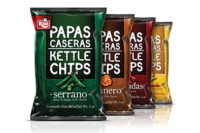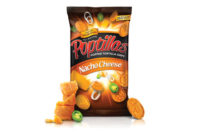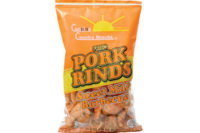Snacking is really evolving this year, serving as a meal substitute in daily eating, rather than just as ‘a quick bite.’ Snacks are also becoming healthier, or at least attempting to do so. Along with better-for-you, fun and unusual flavors are a huge trend this year.
Snacks are hanging tough, despite a highly competitive market and a still underachieving economy. Cracker and popcorn sales were hit especially hard, with fairly flat figures or declines, according to Chicago-based research firm IRI. Even many of the national brands saw decreases over the last 52 weeks ending April 20. Meat snacks, nuts and trail mix fared better, perhaps because of the protein trend.
Snackers are also snacking more often, and many of the snack foods they enjoy are replacing meals. Snacking occasions are becoming more like meals. And more meals are becoming snacks. How can that be?
It’s because of today’s grab-and-go mentality, changing work demands, commuting, increased school activities for kids, social interaction and raising families. Says Barry Novick, founder and president of Kitchen Table Bakers, Syosset, NY, “We continue to see growing interest from consumers looking for snacking options that are low in carbohydrates, but still high in protein,” he explains. “More consumers want options they can bring on-the-go and that will curb cravings, but won’t leave them feeling guilty for snacking.”
The Hartman Group indicates that we’re snacking more frequently, as snacks represent more than 50% of our eating occasions, with as many as five occasions a day versus the requisite three square meals of years’ past. About 80% of snacking takes place at home.
“Given these factors, traditional views of mealtime can pretty much be thrown out the window,” says one of the Hartman studies. “The imprint of these dynamic cultural changes is the blurring of the boundaries between ‘snack’ and ‘meal.’ There are cultural and psychological drivers lying beneath the emerging new eating landscape, and three occasions have the most impact in the food industry: Immediate consumption; alone eating; and snacking.”
So snacks are hot. Snacks are bound by fewer rules than meals, though consumers expect snacks to do more for them than ever before in terms of the physical, emotional, social and cultural experiences. And the lines between meals and snack are blurring.
Yet we’re not very loyal to any particular brand anymore. According to a new Deloitte survey, America’s household brands are losing ground, as consumers are pushing their shopping carts past many national brands without a hint of regret in doing so, according to Deloitte’s (www.deloitte.com) American Pantry Study of more than 375 brands across 30 product categories.
“Private-label brands continue to receive the lion’s share of the total salty snack aisle space, but are not necessarily product innovators,” notes Luke Mapp, director of marketing, at Mikesell’s Snack Food Co., a Dayton, OH-based regional chip company. “Rather, they’re product duplicators. But innovation and being first to market can help offset the space losses seen at the shelf level.”
Seven in 10 shoppers (71%) state that they’re spending less on food, beverages and household goods, but don’t feel as though they’re sacrificing much. “National brands are pressured on all sides, from persistent consumer frugality and low brand loyalty to rival and store brand competition,” says Pat Conroy, vice chairman of Deloitte LLP and U.S. Consumer Products leader. “While consumers initially resented buying less-expensive products out of necessity a few years ago, they have changed their tune. They have shifted from a feeling of settling for lower-priced brands to settling in for store brands distinguished by high quality.”
The economy is forcing people to switch to less expensive store brands, says Mapp, adding, “and commodities have also remained very volatile in price fluctuations over the past few years.”
Other financial influences
Just as we reported in our State of the Industry issue on the Bakery Market in June, we’re finding that there are many food company mergers, such as the recent $6.3-billion bid by Tyson Foods for Hillshire Brands. More are likely on the way—but not for the reasons investors may think. It could be a commodity play. Food companies are fighting a devastating drought in the West and a disease epidemic among hogs has hammered the food industry. Mergers are also occurring as the economy strengthens somewhat, and because food is a maturing industry, says Ronald Hill, a professor of marketing and business law at Villanova University in a June CNBC Mergers & Acquisitions article.
“With little growth opportunities outside of changes in health trends...one way to experience growth, at least domestically, is to acquire other providers with the same or different product lines,” states Hill. And mergers and acquisitions by one company can often force other firms to make similar moves in order to stay competitive.
Sally Lyons Wyatt, executive, client strategy and insights at IRI, reported in her State of the Snack Food Industry address at SNAXPO 2014 that the snacking universe is evolving. “Opportunities abound with the right execution,” she says. “The battle for breakfast was intense in 2013, but there are areas of opportunity across the day and occasions to drive growth. In addition, the path to purchase has become increasingly complex, making precise communication inside and outside of the store essential to influence consumers at key decision points.”
The better-for-you factor
Wyatt says that 86% of U.S. consumers eat snacks, and we’re trying to go for healthier ones. And though core snack dollar sales climbed in 2013, core snack volume slid last year, especially in the salty snack, snack bar and cracker categories. Inflationary pricing trends contributed to the dollar sales increases, she notes. “Snack sizes are growing,” she adds. “And the quest for hunger satisfaction is driving savory snack growth.”
The other main evolution in snacking is that consumer scrutiny of all food products has hit an all-time high. The much-in-demand snack market is being greatly influenced by what Packaged Facts calls “healthy snackers,” who wield a lot of market power. Out of the 50 million consumers who snack between meals (and cite salted snacks as their favorite), the healthy snackers are a veritable army of 14.2 million, Packaged Facts reports. Yet these consumers exercise often, and don’t see a conflict between craving a chip (an option traditionally landing in the unhealthy camp) and pursuing a healthy snacking diet.
In the case of popcorn, for example, manufacturers are shifting their focus to its intrinsically healthier attributes. Suffering a setback during the recession, the popcorn industry saw shoppers cutting back on nonessential purchases. But today, shoppers are going back to this snack classic, though they’re purchasing a different popcorn than they did pre-recession. “They’ve become more health-conscious,” says Adriane Little, a category manager at Boulder Brands, Boulder, CO. “The popularity of popcorn heavy in fat, salt and artificial ingredients is waning, and in its place are a plethora of gourmet and natural popcorns sure to satisfy any connoisseur.”
Mark Singleton, vice president of sales and marketing, at Gaslamp Popcorn, Lima, OH, agrees. “The popcorn category will continue to grow,” he says. “Consumers want to find healthier alternatives to their usual savory or sweet snacks. Popcorn can be considered guilt-free snacking, and consumers want more of these options.”
Simple is best?
The same can be said about chips, pretzels, crackers/crisps and tortilla chips of all kinds. “Simple ingredient lists will win the game,” agrees Meyer Futersak, CEO of American Farmer Brands LLC, Cedarhurst, NY. American Farmer’s Sweet & Salty Kettle Popped Corn contains just popcorn, sunflower oil, sugar and salt; similarly, its Light and Skinny Kettle Popped Corn for the health-conscious contains the same ingredients, but cuts 10 calories per serving.
Consumer trends for better-for-you snacks are influencing snack manufacturers across all categories, and many snack brands are listing their healthful benefits and nongenetically modified organisms (nonGMO), gluten-free and kosher certifiers on their packaging labels, to allow consumers to easily make a healthy choice at the store shelf, explains Virginia Bryant, marketing and brand associate at 479°, a San Francisco-based popcorn producer.
Cracker lovers are also looking for healthier options, with more interesting ingredients and flavor profiles, and manufacturers are listening. Better-for-you ingredients are beefing up the cracker aisle, as protein has entered the picture, along with more whole grains, ancient grains and fiber; fewer GMOs; no gluten; and less sodium, fat (especially trans-fat), cholesterol and sugar. Ancient grains are more popular today, because they generally pack more nutritional punch than their conventional counterparts, with higher fiber and mineral content.
“I’d say the snack food category is a healthy segment in terms of sales, and that it’s getting even healthier as it relates to ingredients, nutrition and variety,” states Steve Sklar, senior vice president and general
manager for Inventure Foods Inc., Phoenix.
Fabulous flavors
Snack flavors are all over the map this year, as sriracha, smoky chipotle, jalapeno and various other pepper flavors have become popular, as well as spicy twists on familiar favorites and gourmet cheeses such as Asiago and blue cheese. Combination flavors include things like salty and sweet, toasted sesame and seaweed, and Asian flavors with ginger, as well as the ubiquitous bacon flavor. Even ketchup and dill pickle chips are not just a fad, but are growing in popularity. Still, olive oil and sea salt seem to be one of the most widely available flavors.
“As food manufacturers, the biggest challenge for us is to make sure we keep up with what the consumer needs and expects,” says Cara Figgins, executive vice president of Partners, a Tasteful Choice Co., Seattle. “Consumers want to know what is in the food they eat, they want it to taste good, and they want it to add value to their lives by providing nutrition and making their lives easier.”
Says Mapp: “In general, consumers aren’t as loyal as they used to be and aren’t afraid to explore new brands and flavors. For this reason, our steadfast focus on providing the right quality and taste is key to keeping our customers happy.”
Bob Gould, marketing manager at Snyder’s of Hanover, says consumers crave variety and expect bigger, bolder, nontraditional flavors today. “They are increasingly more welcoming of sweet and salty items in this traditionally savory category,” he explains. “Our recent innovations in our Sweet and Salty pretzel line are a great example of how we are listening to consumer feedback…consumers love flavor, so we plan to continue our flavor expansion and explore different ways to deliver on taste and variety.”
So like many other foods, snacks are evolving, innovating and coping with many consumer and customer demands for that extra-special “something.” Snack manufacturers and marketers are certainly responding with new shapes, flavors, formulations and ingredients. No doubt, snacks are here for the long haul, many enjoying great success, while others keep pace on a rather uphill, rough and rocky road.















